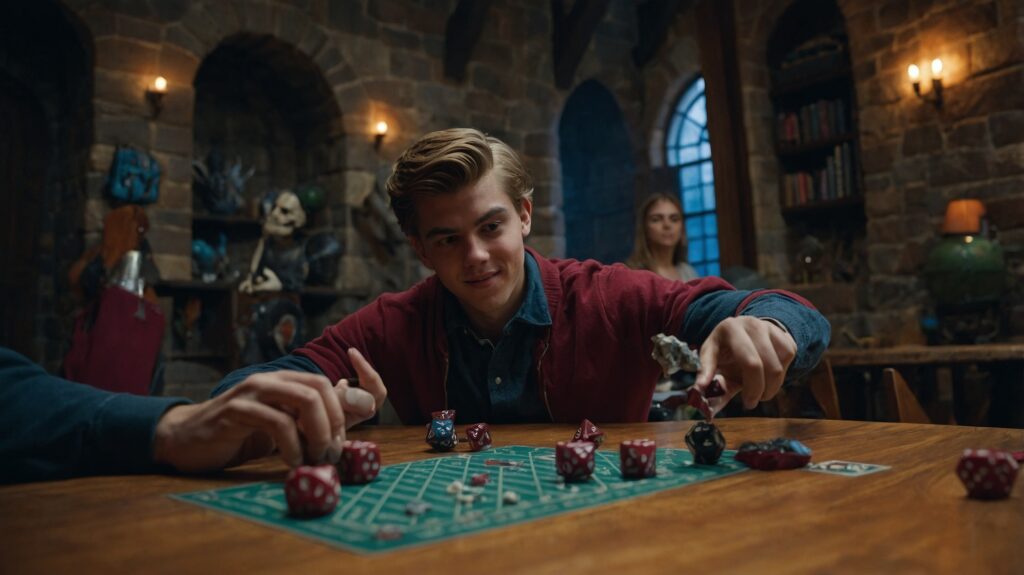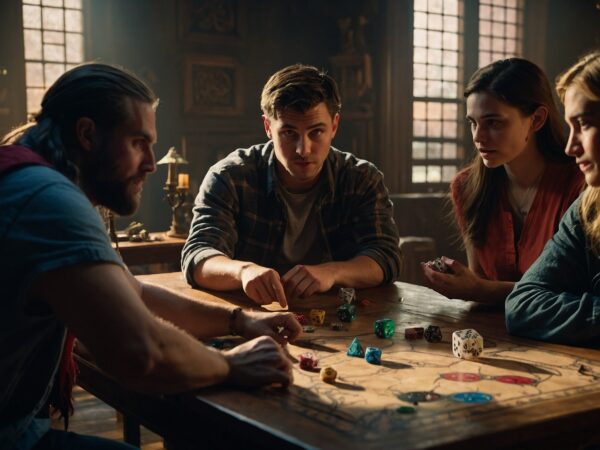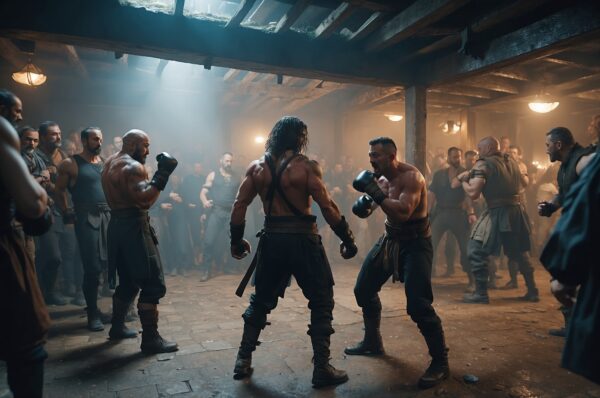When you create a Dungeons & Dragons character it’s one of the most exciting parts of the game. It’s the seed of all the imagination and storytelling that follows, and allows you (the player) to get creative by adding a new hero to the world you and your friends are about to inhabit. Whether you’re envisioning a devilishly charming rogue, a powerful but mad wizard, or a fearless (and thoughtless) barbarian, the process of bringing your hero to life sets the stage for unforgettable adventures. But for new players, the character creation process can seem a little daunting. Don’t worry—we’ve got you covered!
This guide will walk you through every step of creating a D&D character, breaking down each decision and how it impacts your gameplay. Plus, we’ve included downloadable character sheets to make getting started even easier.
Before You Begin: Things to Consider Before Creating Your Character
Creating a Dungeons & Dragons character is a personal and exciting process, but before you dive in, there are a few important things to consider. Talking with your Dungeon Master (DM) and fellow players ahead of time can help you create a character that fits seamlessly into the game and ensures a fun, cooperative experience for everyone at the table.
Talk with Your Dungeon Master
Your DM is your guide to the world you’ll be adventuring in, so it’s essential to get their input before building your character. They can provide valuable insights about the tone, setting, and expectations for the campaign. Here are a few key questions to ask:
- What’s the Campaign Setting? Is the game set in a classic high-fantasy world, a gritty low-magic setting, or something entirely unique? Knowing the setting can inspire your character’s backstory and help you choose traits that fit the world.
- What Level Are We Starting At? Your character’s starting level determines what abilities and features they’ll have at the beginning of the game.
- Are There Any Restrictions or Preferences? Some DMs may limit certain races, classes, or alignments to maintain the tone or balance of the game. They might also have house rules or unique systems to keep in mind.
- What Should I Know About the Story? Without giving away spoilers, the DM might share hints about the campaign’s theme or major challenges, which can help you create a character that feels relevant to the story.
Having this conversation ensures your character is aligned with the campaign and avoids any surprises when the game begins.
Coordinate with Your Group
Dungeons & Dragons is a team game, so it’s important to think about how your character will work alongside the other players. Talking with your group before character creation can help everyone understand their roles and build a well-rounded party.
- What Roles Are Being Filled? A balanced party typically includes a mix of roles, such as:
- Tank: A front-line fighter who can absorb damage (e.g., Barbarian, Fighter).
- Damage Dealer: A character focused on dealing lots of damage (e.g., Rogue, Sorcerer).
- Support: A healer or buffer who helps the party thrive (e.g., Cleric, Bard).
- Utility: A character with skills for solving puzzles, disarming traps, or gathering information (e.g., Ranger, Wizard).
While you don’t need a perfectly balanced group to have fun, it’s helpful to know who’s covering which areas so you can avoid overlaps or gaps.
- How Do Our Characters Know Each Other? Discussing your characters’ relationships or shared histories can create immediate bonds and make the story more immersive. Are you old friends, reluctant allies, or strangers brought together by fate?
- What Playstyles Do We Enjoy? Some players love combat-heavy games, while others prefer roleplaying or puzzle-solving. Understanding everyone’s preferences can help you create a character who fits the group dynamic.
Consider the Tone of the Game
Every D&D campaign has its own tone and style, which can influence the kind of character you create.
- Serious or Silly? In a gritty campaign of political intrigue, a goofy bard might feel out of place, while a grim, brooding rogue could clash with a light-hearted dungeon-crawling adventure.
- Heroic or Morally Gray? Is the party a group of virtuous heroes, or are they morally ambiguous adventurers out for personal gain? Tailoring your character’s motivations to the campaign’s tone helps create a cohesive experience.
Bring a Spirit of Collaboration
The best D&D games are built on teamwork and collaboration. As you create your character, think about how they’ll contribute to the party’s success—not just in combat but also in roleplay and problem-solving. A character who constantly clashes with others or refuses to cooperate can disrupt the game, so try to find a balance between your personal concept and the group dynamic.
By discussing these details with your DM and fellow players, you’ll be well-prepared to create a character that feels like a natural fit for the game. Plus, these conversations set the stage for a campaign that’s cooperative, exciting, and fun for everyone involved. Once you’ve nailed down the basics, you’re ready to dive into the character creation process!

Time to Create your Dungeons & Dragons Character
Now that you’ve got the background details sorted and an idea of what to expect in the game, it’s time for the most exciting part: creating your Dungeons & Dragons character! This is where your vision comes to life, from choosing your race and class to fleshing out their personality and abilities. Whether you’re building a brave hero, a cunning trickster, or something entirely unique, this step-by-step guide will help you craft a character ready to take on epic adventures. Let’s get rolling!
Step 1: Choose a Concept for Your Character
Before diving into mechanics, think about the kind of character you want to play. Are they a stoic warrior driven by revenge? A mischievous trickster out for treasure? Or perhaps a noble healer seeking to aid the world? Start with a general idea and let it guide your choices.
Ask yourself:
- What kind of personality will they have?
- What’s their backstory?
- How do they fit into the world and the adventuring party?
Your concept doesn’t need to be fully fleshed out at this stage—it’ll evolve as you make decisions.
Step 2: Pick Your Race
Your character’s race determines their physical traits, cultural background, and some mechanical bonuses. Each race comes with unique traits and abilities that can influence your playstyle. For example:
- Elf: Agile and perceptive, elves are excellent choices for rangers or wizards.
- Dwarf: Hardy and strong, dwarves make great fighters or clerics.
- Tiefling: With their infernal heritage, tieflings often lean toward magic-focused classes.
When choosing your race, consider how their traits align with your concept. If you’re imagining a stealthy scout, a halfling’s size and dexterity bonuses might be perfect. Check your chosen race’s traits on the character sheet and make note of any ability score increases, special abilities, or languages.
Step 3: Choose a Class
Your class determines your character’s role in the party and the abilities they’ll use in combat and exploration. Are you a spellcaster? A front-line fighter? A support character? D&D offers a variety of options:
Core D&D Classes
These classes are found in the Player’s Handbook and form the foundation of most D&D games:
- Barbarian
- Role: Frontline melee fighter.
- Key Features: Rage, high durability, and devastating physical attacks.
- Flavor: A primal warrior drawing strength from raw emotion and instinct.
- Bard
- Role: Versatile support, spellcaster, and social expert.
- Key Features: Bardic Inspiration, wide spell selection, and Jack of All Trades.
- Flavor: A charismatic performer who uses music and magic to influence the world.
- Cleric
- Role: Divine spellcaster and healer.
- Key Features: Channel Divinity, healing spells, and powerful buffs.
- Flavor: A devotee of a god or divine power, wielding miracles in their name.
- Druid
- Role: Spellcaster with nature and shape-shifting abilities.
- Key Features: Wild Shape, nature-based spells, and summoning abilities.
- Flavor: A guardian of nature, drawing magic from the natural world.
- Fighter
- Role: Versatile combatant, proficient with weapons and armor.
- Key Features: Multiple attacks, ability score improvements, and fighting styles.
- Flavor: A master of combat, excelling in various forms of physical prowess.
- Monk
- Role: Agile melee combatant with mystical abilities.
- Key Features: Martial arts, Ki points, and unarmored defense.
- Flavor: A disciplined warrior harnessing inner energy for incredible feats.
- Paladin
- Role: Tank, melee fighter, and support caster.
- Key Features: Divine Smite, auras, and healing abilities.
- Flavor: A holy knight bound by an oath to uphold a sacred cause.
- Ranger
- Role: Skilled tracker, ranged or melee fighter.
- Key Features: Favored Enemy, spellcasting, and combat versatility.
- Flavor: A wilderness expert, adept at survival and striking from the shadows.
- Rogue
- Role: Stealthy and cunning damage dealer.
- Key Features: Sneak Attack, evasion, and expertise in skills.
- Flavor: A resourceful adventurer who thrives on cunning and precision.
- Sorcerer
- Role: Arcane spellcaster with innate magical abilities.
- Key Features: Sorcery Points, Metamagic, and powerful spells.
- Flavor: A natural-born spellcaster whose magic comes from within.
- Warlock
- Role: Spellcaster with a magical pact.
- Key Features: Eldritch Invocations, Pact Boons, and short-rest spell slots.
- Flavor: A wielder of arcane power granted by a pact with a mysterious entity.
- Wizard
- Role: Versatile arcane spellcaster.
- Key Features: Extensive spellbook, ritual casting, and spell versatility.
- Flavor: A scholarly master of magic who studies ancient tomes to wield spells.
Additional Classes
Other classes are introduced in secondary books like Xanathar’s Guide to Everything, Tasha’s Cauldron of Everything, and other supplementary source materials.
- Artificer (Eberron: Rising from the Last War and Tasha’s Cauldron of Everything)
- Role: Inventor and support spellcaster.
- Key Features: Infusions, magical gadgets, and mechanical companions.
- Flavor: A brilliant creator who blends magic and technology into powerful tools.
Your class also determines your hit points, proficiencies, and starting abilities. Review the options and pick the one that excites you the most. Many players choose a class that complements their race, but feel free to mix and match to create something unique.
Step 4: Assign Ability Scores
D&D characters are defined by six ability scores: Strength, Dexterity, Constitution, Intelligence, Wisdom, and Charisma. These scores determine how well your character performs in different areas.
Methods for Generating Ability Scores
- Standard Array: Assign these fixed numbers (15, 14, 13, 12, 10, 8) to your abilities.
- Point Buy: Distribute a set number of points to customize your stats.
- Rolling Dice: Roll 4d6, drop the lowest die, and sum the rest for each stat.
Assign Scores Based on Your Class
Your class determines which abilities are most important:
- Fighters prioritize Strength or Dexterity for combat.
- Wizards rely on Intelligence for their spells.
- Rogues need Dexterity for stealth and finesse.
Assign your highest scores to your class’s primary abilities and distribute the rest to fit your character’s concept.
Once you’ve determined your scores, write them in the appropriate boxes.
- Ability Modifiers: Calculate the modifier for each score using this formula:
(Ability Score−10)÷2 (round down)For example, a Strength score of 16 has a modifier of +3. Write the modifier next to each score.
- Saving Throws: Your class grants proficiency in certain saving throws (e.g., Dexterity and Wisdom for Monks). Mark these as proficient and add your proficiency bonus to the ability modifier. For example, a proficient Dexterity saving throw with a +2 Dexterity modifier and a +2 proficiency bonus would be +4.
Keep these scores handy—they’re used frequently in combat and skill checks.
Step 5: Select a Background
Your background adds flavor and mechanical benefits, representing your character’s life before adventuring. Each background provides extra skill proficiencies, tool proficiencies, starting equipment, and roleplaying features.
Examples include:
- Sage: Perfect for scholarly wizards or inquisitive adventurers.
- Soldier: Ideal for battle-hardened fighters or disciplined paladins.
- Criminal: A natural choice for rogues and stealthy characters.
Choose a background that aligns with your concept and think about how it informs your character’s personality and motivations.
Step 6: Identify Your Skills
The skills section lists specific areas your character excels in, such as Stealth, Perception, or Persuasion. Here’s how to fill it out:
- Proficiencies: Your class, race, and background grant skill proficiencies. Mark these skills as proficient on your sheet.
- Calculate Bonuses: Each skill is tied to an ability score. For example, Stealth is based on Dexterity. Add your proficiency bonus to the relevant ability modifier for skills you’re proficient in. For non-proficient skills, just use the ability modifier.
- Example: A rogue with proficiency in Stealth, a Dexterity modifier of +3, and a proficiency bonus of +2 would have a Stealth bonus of +5.
Your skill bonuses will be your go-to for making checks during exploration, combat, and roleplay.
Step 7: Get Your Gear & Equipment
The equipment section keeps track of your character’s gear, including weapons, armor, and adventuring tools.
- Starting Equipment: Your class and background grant specific starting gear. Write these items in your inventory, including any weapons, armor, tools, or miscellaneous gear (like a bedroll or rations).
- Weapons: For each weapon, record its:
- Name (e.g., Longsword, Shortbow).
- Attack Bonus: This is your proficiency bonus plus the relevant ability modifier (Strength for melee, Dexterity for ranged).
- Damage: Write the damage dice and type (e.g., 1d8 slashing).
- Armor: Record the type of armor you’re wearing and its impact on your Armor Class (AC).
- Other Gear: Include adventuring items, tools, and magic items. Note any special properties or effects they have.
Keeping this section organized ensures you’re ready for combat and exploration without missing critical details.
Step 8: Additional Features and Traits
Notate on your character sheet the unique abilities and traits your character has, including those granted by their race, class, and background.
- Racial Traits: Record abilities such as Darkvision, resistance to certain damage types, or extra languages.
- Class Features: Write down the features granted by your class, such as a Fighter’s Second Wind or a Bard’s Bardic Inspiration. Include usage limits (e.g., “1/rest”) for abilities.
- Background Features: Note any additional traits from your background, such as the Folk Hero’s rustic hospitality.
- Feats (if applicable): If your character has feats, record them here, including their effects and any conditions for use.
This section acts as a quick reference during gameplay, so include short descriptions or page references for abilities if needed.
Step 9: Hit Points and Armor Class
Your hit points (HP) and armor class (AC) are critical for surviving combat encounters.
Hit Points:
In Dungeons & Dragons, Hit Points (HP) represent your character’s ability to sustain damage and remain conscious during combat or other dangerous situations. Think of hit points as a combination of your character’s physical health, endurance, and sheer willpower. They determine how much damage your character can take before they are knocked out or worse.
-
- Starting HP: Based on your class, roll your hit die (or use the fixed value) and add your Constitution modifier to determine your starting HP. For example, a level 1 Fighter with a d10 hit die and a +2 Constitution modifier starts with 10 + 2 = 12 HP.
- Temporary HP: Use this section to track any temporary hit points granted by spells or abilities.
Gaining Hit Points When Leveling Up
Each time you level up, your HP increases:
- Roll your class’s hit die or take the fixed average (e.g., 5 for a d8, 6 for a d10).
- Add your Constitution modifier to the result.
- Add this total to your current HP.
For instance, if the same Fighter levels up to level 2 and rolls a 6 on their d10 hit die, their new HP is
12 (previous total) + 6 (roll) + 2 (modifier) = 20 HP.
Armor Class (AC):
Your AC determines how difficult you are to hit in combat.
-
-
- Calculate your AC based on your armor and Dexterity modifier. For example, leather armor (AC 11) plus a +2 Dexterity modifier gives you an AC of 13.
- If you’re not wearing armor, use your class’s base AC formula (e.g., a Barbarian’s Unarmored Defense).
-
Keep this section updated throughout the game to reflect temporary changes or effects.
Step 10: Add Personality and Final Touches
Bring your character to life by adding personal details. Think about:
- Appearance: What do they look like?
- Personality Traits: What are their quirks, strengths, and weaknesses?
- Bonds, Ideals, and Flaws: What drives them? What do they fear?
Feel free to customize your character sheet with color, artwork, or doodles to make it uniquely yours!
Your Adventure Awaits!
Congratulations—you’ve created your very own D&D character! Whether you’re stepping into a sprawling campaign or a one-shot adventure, your hero is ready to embark on thrilling quests, face dangerous foes, and build lasting memories. Remember, your character will grow and evolve with every session, so embrace the journey and have fun exploring their story.
Now grab your dice, meet your party, and get ready to roll for initiative!







